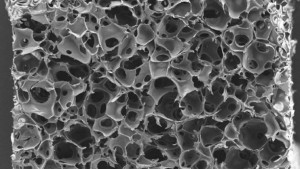Inducing and controlling the regeneration of tissues by implantation of biomaterials is a preeminent goal of Regenerative Medicine. Critical size bone defects are an example for an often occurring clinical challenge. Scientists of the German Institute of Biomaterial Science together with scientists from Berlin and Rostock reported on a purely polymeric 3D-architectured hydrogel (ArcGel), which successfully guided the in vivo bone regeneration in rats. The biological effect is purely material driven, an addition of cells or bioactive factors is not required.

The design principle for ArcGels was going beyond compromises in multifunctionality. The complex requirements for functions were realized by a hierarchical organization of the hydrogel, in which different functions were implemented at different levels. The multifunctional material is build up only from amino acids, with the material being synthesized and shaped in an integrated one-step procedure.
The molecular level is associated to cell adhesion and hydrolytic degradability, the level of pore walls relates to local mechanics and tension of polymer chains, while the porous architecture enables cell invasion, form stability, and shape recovery. The macroscopic level is related to the elastic recoverability with a defined compression module. The implementation of the functions on different levels enables adjusting of local elasticities independently from macroscopic mechanical properties.
Furthermore, ArcGels show a water-induced shape-memory effect. The ArcGels display a unique degradation profile with pore size growth similar to merging soap bubbles during the course of hydrolytic degradation while ensuring material integrity. Implanted in a critical bone defect in a rat model, a comparable healing capacity induced by an ArcGel to that of the clinical standard, cancellous bone graft was observed. It is remarkable that a rapidly degrading material can induce such an osteoinductive effect.
Axel T. Neffe, Benjamin F. Pierce, Giuseppe Tronci, Nan Ma, Erik Pittermann, Tim Gebauer, Oliver Frank, Michael Schossig, Xun Xu, Bettina M. Willie, Michèle Forner, Agnes Ellinghaus, Jasmin Lienau, Georg N. Duda, and Andreas Lendlein; One Step Creation of Multifunctional 3D Architectured Hydrogels Inducing Bone Regeneration; Advanced Materials, 2015, DOI: 10.1002/adma.201404787
Publication
Contact
Prof. Dr. Andreas Lendlein
Institute of Biomaterial Science
Helmholtz-Zentrum Geesthacht
Kantstr. 55, 14513 Teltow, Germany
Tel: +49 (0) 3328 352 450
E-Mail: andreas.lendlein@hzg.de
Source
Helmholtz-Zentrum Geesthacht, press release, 2015-02-13.
Supplier
Advanced Materials (Wiley)
Helmholtz-Zentrum Geesthacht
Share
Renewable Carbon News – Daily Newsletter
Subscribe to our daily email newsletter – the world's leading newsletter on renewable materials and chemicals









